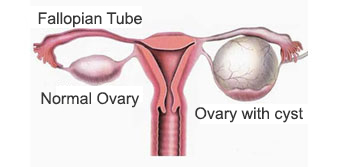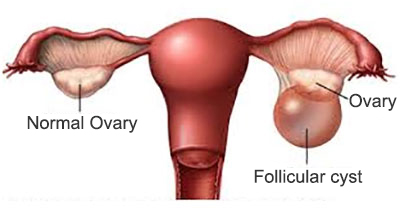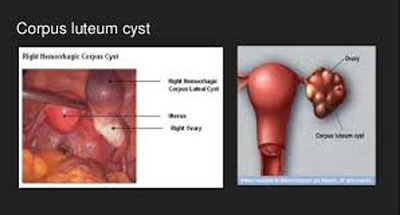Ovarian Cyst
What are ovarian cysts?
A solid or fluid-filled sac or pocket (cyst) within or on the surface of an ovary. Many women will develop at least one cyst during their lifetime. In most cases, cysts are painless and cause no symptoms.

What are the different types of ovarian cysts?
Functional cysts are the most common type. The two types of functional cysts include:
Follicular cyst -

Corpus luteum cysts -

Other types of ovarian cysts include:
Dermoid cysts -

Cystadenomas
Endometrioma
Some women develop a condition called polycystic ovary syndrome. This condition means the ovaries contain a large number of small cysts. It can cause the ovaries to enlarge. If left untreated, polycystic ovaries can cause infertility.
What are the symptoms of ovarian cysts?
Often times, ovarian cysts do not cause any symptoms. However, symptoms can appear as the cyst grows. Symptoms may include:
 abdominal bloating or swelling
abdominal bloating or swelling painful bowel movements
painful bowel movements pelvic pain before or during the menstrual cycle
pelvic pain before or during the menstrual cycle painful intercourse
painful intercourse pain in the lower back or thighs
pain in the lower back or thighs breast tenderness
breast tenderness nausea and vomiting
nausea and vomiting
Severe symptoms of an ovarian cyst that require immediate medical attention include:
 severe or sharp pelvic pain
severe or sharp pelvic pain fever
fever faintness or dizziness
faintness or dizziness rapid breathing
rapid breathing
These symptoms can indicate a ruptured cyst or an ovarian torsion. Both complications can have serious consequences if not treated early.
How are ovarian cysts diagnosed?
For a proper diagnosis, you’ll need to see a gynecologist to get a pelvic exam. This exam is used to check the size, location, shape, and composition (solid or fluid filled) of a cyst. You may also need other tests, which include:
 Ultrasound
Ultrasound CT scans
CT scans MRI
MRI
How are ovarian cysts treated?
It can be treated with medication or might need operation. Your doctor will decide which one is best for you.



